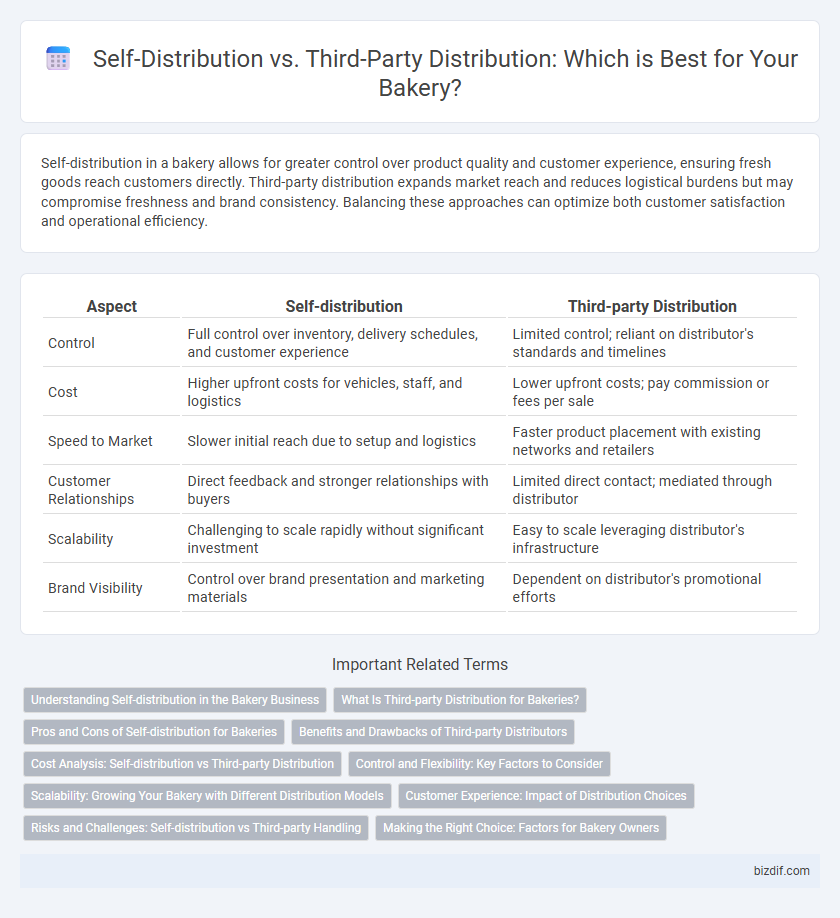Self-distribution in a bakery allows for greater control over product quality and customer experience, ensuring fresh goods reach customers directly. Third-party distribution expands market reach and reduces logistical burdens but may compromise freshness and brand consistency. Balancing these approaches can optimize both customer satisfaction and operational efficiency.
Table of Comparison
| Aspect | Self-distribution | Third-party Distribution |
|---|---|---|
| Control | Full control over inventory, delivery schedules, and customer experience | Limited control; reliant on distributor's standards and timelines |
| Cost | Higher upfront costs for vehicles, staff, and logistics | Lower upfront costs; pay commission or fees per sale |
| Speed to Market | Slower initial reach due to setup and logistics | Faster product placement with existing networks and retailers |
| Customer Relationships | Direct feedback and stronger relationships with buyers | Limited direct contact; mediated through distributor |
| Scalability | Challenging to scale rapidly without significant investment | Easy to scale leveraging distributor's infrastructure |
| Brand Visibility | Control over brand presentation and marketing materials | Dependent on distributor's promotional efforts |
Understanding Self-distribution in the Bakery Business
Self-distribution in the bakery business involves managing the entire supply chain from production to delivery, enabling direct control over product quality and customer relationships. This approach often results in higher profit margins by eliminating third-party fees and allows for flexibility in scheduling and routing deliveries. Bakeries utilizing self-distribution can quickly adapt to customer demand and streamline inventory management, enhancing operational efficiency and brand consistency.
What Is Third-party Distribution for Bakeries?
Third-party distribution for bakeries involves outsourcing the delivery and logistics of products to an external company specializing in transportation and supply chain management. This method allows bakeries to reach a wider customer base without investing in their own delivery infrastructure or fleet. Utilizing third-party distributors can improve efficiency, reduce operational costs, and provide access to established networks for faster and broader product distribution.
Pros and Cons of Self-distribution for Bakeries
Self-distribution enables bakeries to maintain complete control over product quality, delivery schedules, and customer relationships, fostering brand loyalty and immediate feedback. However, it requires significant investment in logistics, vehicles, and staff, leading to higher operational costs and complexities in scaling. Small to medium-sized bakeries may struggle with efficiency and reach compared to third-party distributors who offer broader market access and established distribution networks.
Benefits and Drawbacks of Third-party Distributors
Third-party distributors offer bakeries expanded market reach and reduced logistics burden, allowing focus on core baking operations. However, these distributors often charge substantial fees and may limit control over product placement and brand messaging. Relying on third-party distribution can lead to slower communication and potential quality issues compared to self-distribution.
Cost Analysis: Self-distribution vs Third-party Distribution
Self-distribution in a bakery typically incurs higher upfront costs due to vehicle maintenance, fuel, and staffing but offers greater control over delivery schedules and customer interaction. Third-party distribution reduces operational expenses by outsourcing logistics and leveraging established delivery networks, which can lower fixed costs but increase variable fees per order. Carefully analyzing volume, delivery frequency, and geographic reach helps determine whether self-distribution or third-party services yield better overall cost efficiency for bakery operations.
Control and Flexibility: Key Factors to Consider
Self-distribution in a bakery allows direct control over product quality, pricing, and customer interaction, fostering brand consistency and immediate feedback. Third-party distribution offers broader market reach and operational scalability but limits flexibility in product presentation and timing. Choosing between these options hinges on balancing control over brand experience with the desire for expanded distribution channels.
Scalability: Growing Your Bakery with Different Distribution Models
Self-distribution offers bakeries complete control over product quality and customer experience but can limit scalability due to resource constraints. Third-party distribution enables rapid expansion by leveraging established networks and logistics, increasing market reach without heavy investment in infrastructure. Balancing both models allows bakeries to scale efficiently while maintaining brand consistency and meeting growing demand.
Customer Experience: Impact of Distribution Choices
Self-distribution in bakeries allows for direct control over product quality, freshness, and personalized customer interactions, leading to enhanced customer satisfaction and brand loyalty. Third-party distribution expands market reach but may reduce the bakery's ability to guarantee product consistency and timely deliveries. Choosing between these methods impacts customer experience by balancing broad accessibility with the assurance of artisanal freshness and service.
Risks and Challenges: Self-distribution vs Third-party Handling
Self-distribution in bakery businesses demands significant investment in logistics, including fleet management, delivery staff, and route optimization, which can increase operational complexity and costs. Third-party distribution offers scalability and broader market reach but introduces challenges such as reduced control over product handling, potential delays, and reliance on external partners' quality standards. Balancing risks involves assessing factors like perishability of baked goods, customer service consistency, and the ability to respond swiftly to market changes.
Making the Right Choice: Factors for Bakery Owners
Bakery owners must evaluate factors like cost-efficiency, control over product quality, and delivery speed when choosing between self-distribution and third-party distribution. Self-distribution offers direct customer interaction and brand consistency, while third-party services provide scalability and reduced logistical burden. Assessing order volume, geographic reach, and resource availability ensures the most effective distribution model tailored to bakery business goals.
Self-distribution vs Third-party Distribution Infographic

 bizdif.com
bizdif.com